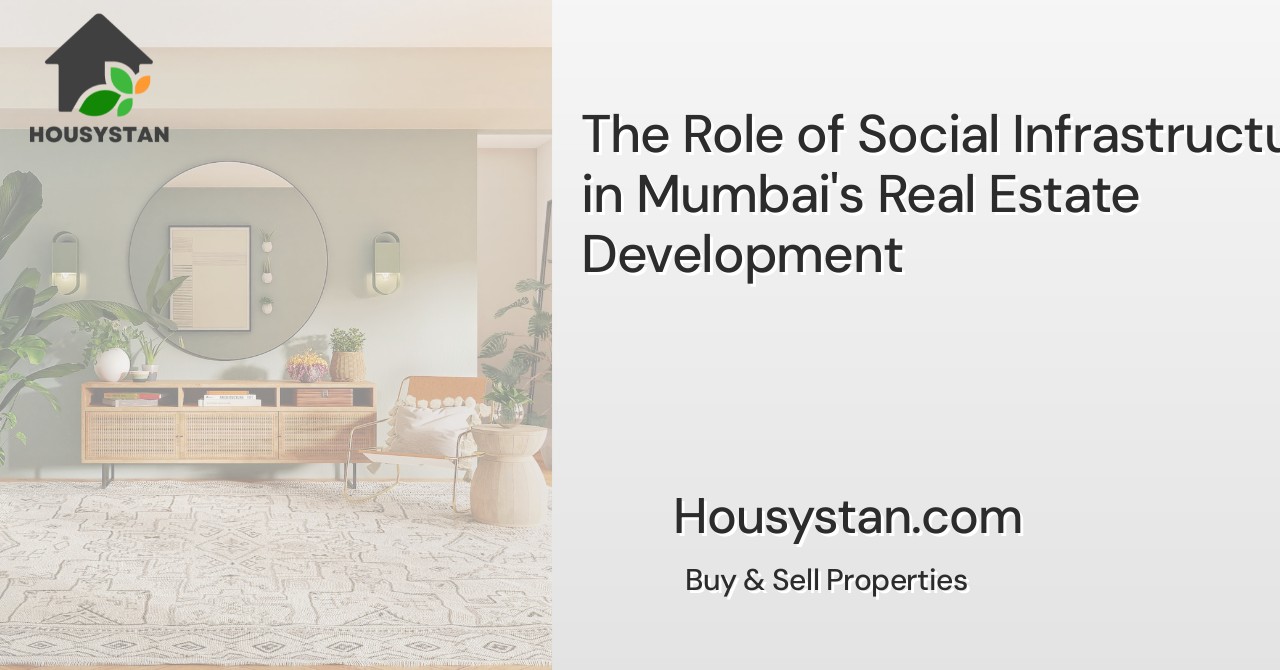The Role of Social Infrastructure in Mumbai's Real Estate Development
Read latest blogs and articles from Housystan

The Information mentioned here was last updated on:
13/1/2026The Role of Social Infrastructure in Mumbai's Real Estate Development
Mumbai, often dubbed the financial capital of India, is a city that never sleeps. Its towering skyscrapers, bustling streets, and diverse population make it a melting pot of cultures and ambitions. But what often goes unnoticed amid the city's glitz and glamour is the critical role that social infrastructure plays in shaping real estate development. In this blog post, we delve into the significance of social infrastructure in Mumbai's real estate landscape, exploring how it impacts property values, lifestyle, and city planning.
What is Social Infrastructure?
- Verified Tenants/Buyers
- Unlimited Property Listing
- Zero subscription/charges fee
Before we explore its impact, it's essential to understand what social infrastructure entails. Social infrastructure includes all the facilities and services that support the quality of life in a community. This encompasses:
- Educational institutions: Schools, colleges, and universities.
- Healthcare facilities: Hospitals, clinics, and specialized medical centers.
- Public amenities: Parks, community centers, and recreational areas.
- Transport networks: Roads, public transport systems, and connectivity solutions.
- Safety and security: Police stations and fire brigades.
These components are crucial in creating a conducive environment for residents, ultimately affecting real estate development and growth in the city.
How Social Infrastructure Drives Real Estate Development
1. Enhancing Property Values
One of the primary ways social infrastructure impacts real estate is by directly influencing property values. Homes located near well-established social amenities typically enjoy higher market values due to:
- Convenience: Proximity to schools, hospitals, and transport networks means residents spend less time commuting.
- Desirable lifestyle: Access to parks, cultural hubs, and recreational areas enhances the quality of life, making these communities more attractive to potential buyers.
Investors and developers often scout locations with robust social infrastructure to ensure their properties command premium prices and attract a steady stream of buyers or tenants.
2. Shaping Community Development
Developers are often guided by existing social infrastructure when planning new projects. Areas with a solid base of amenities are more likely to attract residential and commercial developments due to:
- Demand: Prospective homeowners and businesses prefer settling in well-connected localities.
- Community growth: Such areas are often seen as more stable and secure, promoting long-term occupancy and community cohesion.
3. Driving Economic Activity
Social infrastructure is a catalyst for economic growth, which in turn influences real estate development. Here's how:
- Employment opportunities: Schools, hospitals, and other facilities provide jobs, attracting working professionals who seek housing nearby.
- Increased foot traffic: Improved transport networks and public amenities bring in more visitors, boosting local businesses and encouraging further commercial real estate projects.
Key Areas of Focus in Mumbai
Iconic Neighborhoods
Mumbai boasts several neighborhoods where social infrastructure has significantly shaped the real estate landscape:
- Bandra and Juhu: Known for their vibrant cultural scene and upscale amenities, these areas have seen a surge in luxury real estate.
- Powai: With its well-planned townships and IT parks, Powai exemplifies how integrated development can transform a locality into a sought-after real estate hub.
Emerging Localities
As the city expands, new areas are emerging as hotspots for real estate development due to burgeoning social infrastructure:
- Navi Mumbai: With new schools, hospitals, and enhanced connectivity through the upcoming Navi Mumbai International Airport, this region is poised for growth.
- Thane: Affordable housing combined with improving transport networks and public amenities is drawing both developers and buyers.
Urban Planning and Policy Initiatives
Government Programs
Several government initiatives prioritize enhancing social infrastructure to support real estate growth:
- Smart City Mission: Aims to modernize urban infrastructure, making cities more livable and sustainable.
- Mumbai Development Plan 2034: A blueprint that focuses on improving public amenities, transport systems, and green spaces, aligning with real estate development goals.
Public and Private Partnerships
Collaboration between the government and private players is vital in developing social infrastructure. By leveraging resources from both sectors, projects can deliver cost-effective and efficient solutions, further boosting real estate prospects.
Challenges and Considerations
While social infrastructure plays a pivotal role, real estate development in Mumbai faces challenges:
- Space constraints: The city's dense population and limited land availability complicate infrastructure expansion.
- Environmental concerns: Balancing development with sustainability is crucial to avoid overburdening natural resources and maintaining a healthy urban ecosystem.
Trends in Real Estate Development
As social infrastructure continues to impact Mumbai's real estate scene, several trends are emerging:
- Integrated townships: These self-contained communities blend residential, commercial, and social amenities, offering convenience and a wholesome lifestyle.
- Mixed-use developments: Combining residential, office, and retail spaces caters to the evolving needs of urban dwellers in search of work-life balance.
Tools for Homebuyers and Investors
For those looking to invest in Mumbai's real estate market, considering social infrastructure is key:
- Market analysis: Evaluate the availability and quality of nearby amenities and transport links.
- Property lifecycle: Consider long-term value growth based on planned infrastructure projects and emerging trends.
Conclusion
Social infrastructure undeniably plays a crucial role in shaping Mumbai's real estate landscape. From boosting property values and fostering community development to driving economic activity and guiding urban planning, its influence is expansive and profound. As Mumbai continues to grow and evolve, the integration and enhancement of social infrastructure will remain a critical factor in the city's development journey.